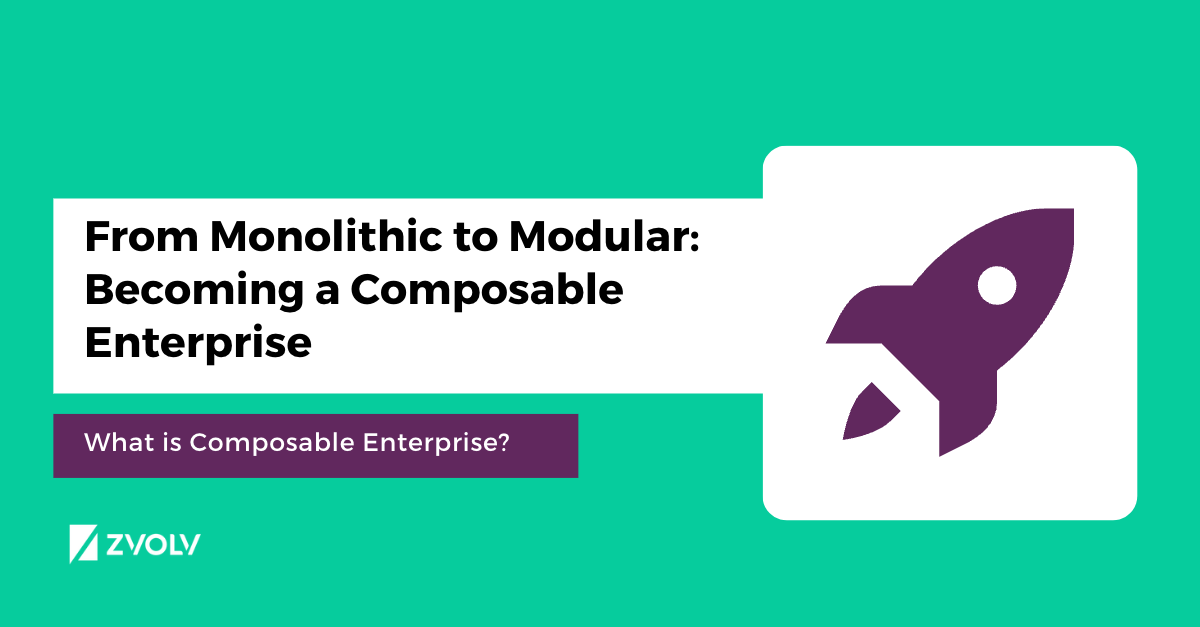For any business looking to constantly innovate and stay ahead of the competition, the concept of a “composable enterprise” is a must.
Coined by Gartner, a composable enterprise is “an organization that delivers business outcomes and adapts to the pace of business change. It does this through assembling and combining packaged business capabilities… application building blocks that have been purchased or developed.”
The idea behind this approach is that it allows businesses to be more flexible and responsive to changing customer needs and new technologies. Instead of using a single, monolithic application, a composable enterprise can easily integrate new technologies and capabilities. It means that businesses can adapt more quickly and deliver more personalized, connected customer experiences.
What is Composable Enterprise?
A composable enterprise is a business that leverages the power of low-code no-code automation platforms or the API economy (a business model that generates value by making services and data accessible through APIs) to break down its offerings into smaller, modular components.
It could mean using microservices, which are individual services that can be combined to create a larger application, or packaged business capabilities (PBCs),
PBC are the building blocks of composable enterprises. They are applications or software components developed specifically for a particular business function. PBCs are independently deployable and can be used separately or easily integrated into larger systems.
A composable approach allows for more flexibility and efficiency in service delivery and software development, moving away from monolithic technology suites and code-based development. PBCs are also designed to be easily consumed by end-users and serve as building blocks for larger user experiences.
Hyperautomation: The Enabler of Composable Enterprise
The need for composable enterprise arises from specific challenges faced by businesses today, such as:
- the complexity of operations,
- dynamic markets,
- the inflexibility of monolithic systems,
- Limited service delivery options,
- and difficulty in software development.
Hyperautomation, therefore, is a game-changer for building a composable enterprise.
Hyperautomation breaks down systems and processes into smaller, independently deployable components. It allows organizations to easily integrate new technologies and innovate as they arise. It also provides a set of tools that automate and optimize processes, allowing organizations to be more agile and responsive to changing market conditions and customer needs.
Hyperautomation can help businesses to:
- Streamline and optimize processes by automating repetitive and manual tasks, eliminating bottlenecks, and increasing efficiency.
- Provide greater flexibility by allowing organizations to easily add or remove automation components as needed, making it easier to adapt to changing market conditions and customer needs.
- Improve data-driven decision-making by providing access to real-time data and insights, allowing organizations to make better-informed decisions and improve their operations.
- Enhance customer experience by providing faster and more personalized service to customers, improving the overall customer experience.
Building Composable Enterprise with Low-code No-code Platforms
Low-code development platforms have become a key strategy to accelerate app delivery and support digital business transformation, according to Forrester Research. They have the potential to make software development up to ten times faster than traditional methods by using visual composition and a modeling-based approach.
A good low-code platform can drive the creation of a composable enterprise in two ways:
By enabling the rapid development of modern PBCs that deliver cutting-edge functionality without rebuilding the organizational core, thereby protecting decades of investments in legacy and core applications.
By providing the ability to create applications through composition and abstraction with a modeling-driven application environment. It lets organizations create customer-centric business applications that deliver a dynamic omnichannel experience and drive the end-to-end customer journey.
To drive a composable enterprise, a low-code platform must have a wide range of capabilities, including:
- Accelerating pro-grade development through modular, modeling-driven, and abstraction-oriented development.
- Supporting a variety of business and technological needs such as workflows, content management, straight-through transactions, mobile apps, collaboration, customer self-service, omnichannel customer engagement, and automated business rules.
- Offering service-oriented integration that can extend beyond organizational boundaries.
- Enabling the rationalization of the application portfolio by helping to avoid the introduction of multiple point solutions and quickly developing various applications.
- Preventing shadow IT through central governance, visibility, and guardrails without hindering innovation.
- Enabling agile, continuous integration/continuous delivery (CI/CD), and adherence to quality standards and architectural requirements.
- Enabling and even catalyzing change with traceability, thereby ensuring the long-term sustainability of business applications.
Zvolv offers all this and a lot more. Schedule a consultation to get started and see how our low-code no-code platform can help you become a composable enterprise.
What Lies Ahead
With the composable infrastructure and applications market likely to grow at a CAGR of 20.21% and reach $14.35bn by 2028, one thing is clear, composable enterprise is the future.
One of the key trends in the future of composable enterprise is the integration of advanced technologies such as AI and machine learning to automate more processes and make more data-driven decisions.
There will be an increasing adoption of cloud-based and SaaS solutions as they offer greater flexibility and scalability and make it easier for organizations to access the latest technologies and updates.
Low-code and no-code platforms will also play a significant role in the future of a composable enterprise. It will allow more organizations, regardless of their technical expertise, to build composable enterprises and take advantage of their benefits.
In addition, we can expect the creation of interconnected ecosystems of multiple, interchangeable applications. With this, organizations can easily discover, consume and connect to the various business capabilities other organizations offer. It will further drive the composable enterprise model, making it more commonplace.
Overall, the composable enterprise is a powerful tool that can help organizations meet the challenges of the digital age. We expect to see more businesses embracing this model in the future.



